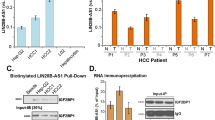Abstract
HCCA2 (hepatocellular carcinoma-associated gene 2) was initially identified as a HCC (hepatocellular carcinoma)-specific protein and subsequently, a long splice variant of HCCA2 was identified as a co-activator of transcription factor YY1 (Yin Yang 1). To investigate the role of HCCA2 in HCC genesis and progression, we screened a human fetal liver cDNA library and identified a novel HCCA2-interacting protein, MAD2L2 (MAD2 mitotic arrest deficient-like 2 (yeast)). The interaction between HCCA2 and MAD2L2 was confirmed by in vitro and in vivo binding assays and the interaction domain was mapped to the N-terminus of HCCA2 by sequential deletion. HCCA2 and MAD2L2 also colocalized in the nucleus of Hela cells. Furthermore, overexpression of HCCA2 led to cell cycle arrest at G0/G1 phase and therefore inhibited cell proliferation. Our research suggests that HCCA2 may play a novel role in cell cycle regulation.




Similar content being viewed by others
Reference
Okabe H, Satoh S, Kato T et al (2001) Genome-wide analysis of gene expression in human hepatocellular carcinomas using CDNA microarray: identification of genes involved in viral carcinogenesis and tumor Progression. Cancer Res 61:2129–2137
Wang ZX, Wang HY, Wu MC (2001) Identification and characterization of a novel human hepatocellular carcinoma-associated gene. Br J Cancer 85:1162–1167
Wang CY, Liang YJ, Lin YS et al (2004) YY1AP, a novel co-activator of YY1. J Biol Chem 279:17750–17755
Gordon S, Akopyan G, Garban H et al (2006) Transcription factor YY1: structure, function, and therapeutic implications in cancer biology. Oncogene 25:1125–1142
Cahill DP, da Costa LT, Carson-Walter EB et al (1999) Characterization of MAD2B and other mitotic spindle checkpoint genes. Genomics 58:181–187
Zachariae W, Nasmyth K (1999) Whose end is destruction: cell division and the anaphase-promoting complex. Genes Dev 13:2039–2058
Harper JW, Burton JL, Solomon MJ (2002) The anaphase-promoting complex: it’s not just for mitosis any more. Genes Dev 16:2179–2206
Fang G, Yu H, Kirschner MW (1998) The checkpoint protein MAD2 and the mitotic regulator CDC20 form a ternary complex with the anaphase-promoting complex to control anaphase initiation. Genes Dev 12:1871–1883
Chen RH, Brady DM, Smith D et al (1999) The spindle checkpoint of budding yeast depends on a tight complex between the mad1 and mad2 proteins. Mol Biol Cell 10:2607–2618
Pfleger CM, Salic A, Lee E et al (2001) Inhibition of Cdh1-APC by the MAD2-related protein MAD2L2: a novel mechanism for regulating Cdh1. Genes Dev 15:1759–1764
Chen J, Fang G (2001) MAD2B is an inhibitor of the anaphase-promoting complex. Genes Dev 15:1765–1770
Wasch R, Engelbert D (2005) Anaphase-promoting complex-dependent proteolysis of cell cycle regulators and genomic instability of cancer cells. Oncogene 24:1–10
Castro A, Bernis C, Vigneron S et al (2005) The anaphase-promoting complex: a key factor in the regulation of cell cycle. Oncogene 24:314–325
Castro A, Arlot-Bonnemains Y, Vigneron S et al (2002) APC/Fizzy-Related targets Aurora-A kinase for proteolysis. EMBO Rep 3:457–462
Littlepage LE, Ruderman JV (2002) Identification of a new APC/C recognition domain, the A box, which is required for the Cdh1-dependent destruction of the kinase Aurora-A during mitotic exit. Genes Dev 16:2274–2285
Ayad NG, Rankin S, Murakami M et al (2003) Tome-1, a trigger of mitotic entry, is degraded during G1 via the APC. Cell 113:101–113
Araki M, Wharton RP, Tang Z et al (2003) Degradation of origin recognition complex large subunit by the anaphase-promoting complex in Drosophila. EMBO J 22:6115–6126
Petersen BO, Wagener C, Marinoni F et al (2000) Cell cycle- and cell growth-regulated proteolysis of mammalian CDC6 is dependent on APC-CDH1. Genes Dev 14:2330–2343
Acknowledgments
This work was co-supported by China NSFC grant (3998039), Chinese National Key Grant of Basic Research (2001CB510203), National 863 Program Grants (2002AA227011, 2002BA711A11 and 2006AA02A310), CNHLPP (2004BA711A19), and Shanghai Science and Technology Innovation Program (03DZ14024) to KK. Huo.
Author information
Authors and Affiliations
Corresponding author
Electronic supplementary material
Below is the link to the electronic supplementary material.
Rights and permissions
About this article
Cite this article
Li, L., Shi, Y., Wu, H. et al. Hepatocellular carcinoma-associated gene 2 interacts with MAD2L2. Mol Cell Biochem 304, 297–304 (2007). https://doi.org/10.1007/s11010-007-9512-8
Received:
Accepted:
Published:
Issue Date:
DOI: https://doi.org/10.1007/s11010-007-9512-8




